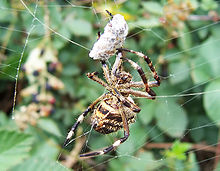
Orb-weaver spiders are members of the spider family Araneidae. They are the most common group of builders of spiral wheel-shaped webs often found in gardens, fields, and forests. The English word "orb" can mean "circular", hence the English name of the group. Araneids have eight similar eyes, hairy or spiny legs, and no stridulating organs.
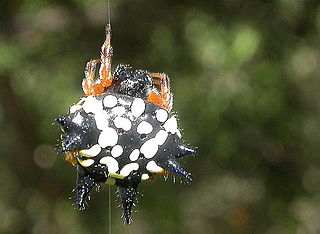
Austracantha is a genus of spider with a single species, Austracantha minax, commonly known as the jewel spider or the Christmas spider. It is a member of the family Araneidae and is endemic to Australia. They are relatively small spiders, reaching a maximum total body length of only around 12 mm (0.47 in) for females, and 5 mm (0.20 in) for males. Their abdomen has six distinctive projections ("spines") that makes them easy to identify. They are predominantly a shiny black, with variable white, yellow, and orange patterns. Melanistic forms also occur during autumn. They are facultatively gregarious, and can be found in large aggregations of overlapping orb webs. They feed on small flying insects that get entangled in their webs. They are harmless to humans, though the webs can be a nuisance for bushwalkers. They are most abundant during the summer months.

Nephila is a genus of araneomorph spiders noted for the impressive webs they weave. Nephila consists of numerous species found in warmer regions around the world, although some species formerly included in the genus have been moved to Trichonephila. They are commonly called golden silk orb-weavers, golden orb-weavers, giant wood spiders, or banana spiders.

A bolas spider is a member of the orb-weaver spider that, instead of spinning a typical orb web, hunts by using one or more sticky "capture blobs" on the end of a silk line, known as a "bolas". By swinging the bolas at flying male moths or moth flies nearby, the spider may snag its prey rather like a fisherman snagging a fish on a hook. Because of this, they are also called angling or fishing spiders. The prey is lured to the spider by the production of up to three sex pheromone-analogues.
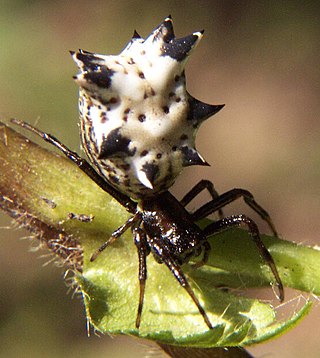
Micrathena gracilis is a spider in the family Araneidae (orb-weavers), commonly known as the spined micrathena or castleback orbweaver. This spider spins a moderately large and very tightly coiled web. The spiders themselves are small and can be found to be anywhere from 4.2 mm to 10.8 mm long. Its venom is harmless to humans. M. gracilis is unique in appearance due to its large spiky abdomen and black and white bodies. Certain spiders of this species can also display a yellow color on the sides of their bodies. These spiders can be seen most active during the end of the summer and beginning of fall. M. gracilis is diurnal and are rarely ever seen active at night.

Nephila pilipes is a species of golden orb-web spider. It resides all over countries in East and Southeast Asia as well as Oceania. It is commonly found in primary and secondary forests and gardens. Females are large and grow to a body size of 30–50 mm, with males growing to 5–6 mm. It is the second largest of the orb-weaving spiders apart from the recently discovered Nephila komaci. The first, second, and fourth pairs of legs of juvenile females have dense hairy brushes, but these brushes disappear as the spider matures.
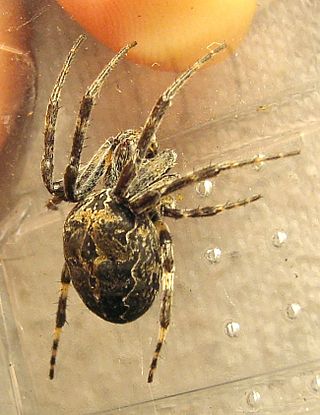
Larinioides sclopetarius, commonly called bridge-spider or gray cross-spider, is a relatively large orb-weaver spider with Holarctic distribution. These spiders originated in Europe, have been observed as south as the Mediterranean Coast and as north as Finland, and have been introduced to North America. They are often found on bridges, especially near light and over water. The species tends to live on steel objects and is seldom seen on vegetation. Females reach a body length of 10–14mm, and males 8–9mm. Their orb webs can have diameters of up to 70 cm.

Gasteracantha cancriformis is a species of orb-weaver spider. It is widely distributed in the New World.

Argiope protensa, commonly known as the tailed grass spider or teardrop spider, is a species of spider in the orb weaver family, Araneidae. This species is fairly common and widespread in Australasia, but like many spider species, little is known of its ecology, biology, or life history.

Trichonephila plumipes, the Pacific golden orb weaver, is a species of spider found in Australia, Indonesia and some Pacific Islands, which exhibits extreme sexual dimorphism through its sexual cannibalism behavior. It is sometimes called the tiger spider due to its markings which look similar to a tiger. This species was formerly called Nephila plumipes. As with other spiders from the genus Nephila, these spiders have a distinct golden web.

Phonognatha graeffei, referred to as the leaf curling spider, is a common Australian spider found in woodlands and urban areas in the northeastern, eastern and southern states. A small member of the family Araneidae, the orb-weavers, it was previously placed in Tetragnathidae.

Araneus mitificus, commonly known as the kidney garden spider or pale orb weaver is a species of orb-weaver spider found in South, East, and Southeast Asia.

Socca pustulosa is a Orb-weaver spider species in the family Araneidae, and it was first described by a French scientist Charles Athanase Walckenaer in 1841 from Tasmania, Australia, but later on when Walckenaer examined the specimen collected from New Zealand and renamed it as a different species- Epeira verrucosa. Until 1917, Dalmas reviewed the Australian pustulosa and New Zealand verrucosa and realized they were the same species. Although S. pustulosa has been accepted for some time in the genus of Eriophora, the evidence supporting its placement within this genus were not fully convincing. Therefore, an alternative view was proposed in 2022- a new genus established to accommodate pustulosa along with 11 other spider species from Australia; the diagnostic test based on haplotype analysis and systematic morphology study by arachnologists and found the anatomical features of male pedipalp terminal apophysis differs from other orb-web species.

Neoscona theisi is a species of spider in the family Araneidae. Spiders in the genus Neoscona have a mostly pantropical distribution.
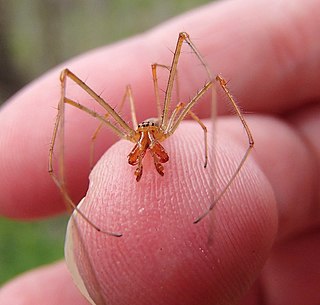
Tetragnatha versicolor is a species of long-jawed orb weaver in the spider family Tetragnathidae. It is found throughout North America, Canada, Central America, and Cuba, but are most common in the United States. T. versicolor is heavily concentrated in New England and the west coast in states like California and Washington. T. versicolor is considered a habitat generalist, and can thrive in many different environments. While they can be found in places like Grasslands, Wetlands, Forests, etc., they prefer dryer areas like normal trees and shrubs. Unlike other spiders in the genus Tetragnatha, T. versicolor will rarely reside near aquatic environments. T. versicolor will typically be colored dark yellow or pale orange and average around 5 mm for males and 6.5 mm for females in length, which is very small for a spider. They are much longer than they are wide, making them very distinct. In addition, T. versicolor can be distinguished from other spiders in Tetragnatha by the distinct separation of the anterior/posterior eyes and the appearance of their reproductive organs. As an orb weaver spider, T. versicolor creates a web to hunt for prey. It will wait at night for prey to stumble into its web and use vibrational signals throughout the web to sense trapped prey. In terms of mating behavior, T. versicolor lacks a distinct courting ritual and will mate with any others in the proximity. Mating behavior is heavily affected by female mating history. In terms of interactions with humans, the bite of T. versicolor is venomous, but not known to cause significant harm.

Artifex melanopyga, synonym Phonognatha melanopyga, referred to as a leaf curling spider, is a common Australian spider found in moist coastal areas of New South Wales and Queensland. A small member of the family Araneidae, the orb-weavers, it was previously placed in Tetragnathidae.
Ordgarius monstrosus is a species of spider in the orb-weaver spider family Araneidae, found in Queensland, Australia. O. monstrosus is a bolas spider. Rather than using a web, adult females catch their prey by using a line with one or two sticky drops which they swing.

Hortophora is a genus of South Pacific orb-weaver spiders first described by V. W. Framenau, R. L. C. Baptista and F. S. M. Oliveira in 2021.

Salsa is an Australasian genus of orb-weaver spiders.
